How to properly prune currants in the summer and what is it for
Sprawling currant bushes quickly lose their shape without proper attention. Thickened plantings become an ideal breeding ground for fungi and insects. Side shoots without pruning grow so much that they cover the central branches from the sun and impair the aeration of the entire bush. In the article we will tell you about pruning currants in the summer, consider whether it is possible to prune red and white currants, and how to do it correctly.
The content of the article
Why cut currants in the summer
Black, white and red currants are members of the Gooseberry family. Perennial shrubs are popular due to their unpretentiousness in care and the sweet and sour taste of berries. Most often, black currants are grown in Russia, less often red and white.
The plants have a compact or spreading crown, depending on the variety, the height reaches 1.5 m. The bushes actively develop up to 2 years, then the green mass gains are suspended and the plants enter the fruiting phase. The first harvest is removed 2 years after planting, but the maximum productivity of currants is observed at the age of 5-6 years.
Currants bear fruit every day, on average 3-7 kg of berries are harvested from the bush... The red and white varieties ripen in late June, the black in mid-July. It is after the harvest that they start pruning the bushes, although the debate about this procedure in the summer does not fade away.
Many gardeners believe that summer pruning improves the light and aeration of the central shoots, so the lateral young shoots develop better. Adherents of a different opinion do not recommend cutting weak shrubs in the summer, since the procedure inhibits the growth of shoots and enhances the generative development of the plant.
Pruning goals

Summer pruning is aimed at changing the direction of shoot growth. Thanks to this, the bushes look attractive and neat, the berries ripen large and sweet.
Gardeners themselves decide whether to prune in the summer or postpone it until the fall. However, the currant tolerates the procedure without loss. Thanks to the correct formation, it is possible to avoid fungal diseases and achieve maximum productivity.
If you ignore pruning, shrubs thicken over time, and dry dead branches block the access to light and air. This causes smaller berries, peduncles and ovaries to become smaller, and the bushes age prematurely.
Formative and rejuvenating currant pruning is performed in spring and autumn. At the same time, dry, diseased, damaged and fertile branches are removed, and the growth of future young shoots is set. An autumn haircut is carried out after the bushes have shed their leaves.
It is important to allow assimilates from old branches to flow into the root system. In winter, the plant will receive vital substances from the reserves.
Timing of pruning
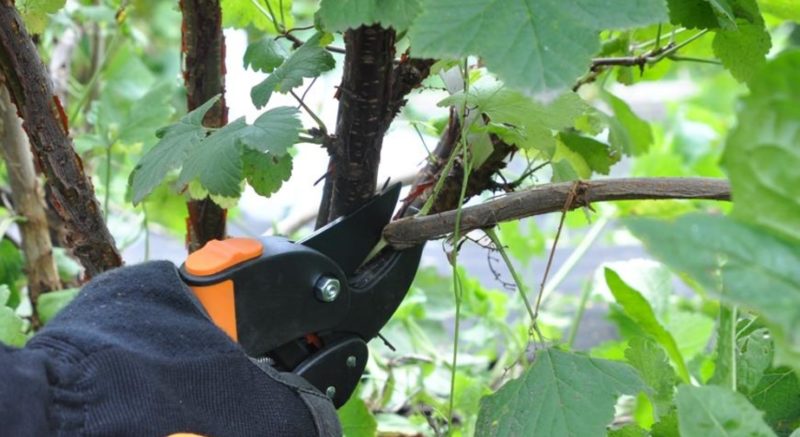
Experienced gardeners recommend performing exclusively sanitary pruning of currants after harvest. The exact timing of the procedure is not provided, it is better to focus on the climatic features of the growing region.
Reference. The procedure is performed in dry weather. Dry and sun-warmed shoots are easier to cut.
The approximate timing of pruning after fruiting is from July to September. In the south, the procedure is performed from mid-June - early July, in the northern regions and regions of the middle zone - from August.
Auspicious days
Adherents of gardening according to the phases of the moon are advised to adhere to the lunar calendar.
Favorable days for pruning currants in 2020:
- June: 1–6, 8, 12, 13, 17–19, 22, 23, 26–28, 30;
- July: 1-3, 7-12, 14-18, 22-31;
- August: 1, 2, 6, 7, 10-16, 20-26, 28, 29;
- September: 1-3, 6-13, 18-24, 29, 30.
Auspicious days for pruning in 2021:
- June: 2, 3, 6–8, 11–13, 16, 19–25, 29, 30;
- July: 4-8, 13-17, 19-23, 27, 28, 31;
- August: 1–6, 10–15, 17–19, 23, 27–31;
- September: 1–3, 8–13, 15, 16, 19, 20, 24–30.
How to properly trim currants
When pruning currants in the summer, it is important to use a sharp disinfected tool and follow the branch removal sequence.
Required materials and tools
Equipment for pruning bushes is pre-disinfected to prevent fungal infections.
For gardening use:
- garden shears (secateurs) to remove young growth;
- lopper for cutting thick branches;
- a knife for correcting uneven areas;
- rake for collecting shoots and foliage;
- medical alcohol, vodka, kerosene, 3% solution of copper sulfate or potassium permanganate for disinfection of equipment.
Step-by-step instructions for pruning
Currant pruning technology:
- Remove all sick, old, moss-covered, dry and damaged branches, as well as those that are 4-5 years old.
- Branches that are strongly inclined and lying on the ground are cut off, since in summer they are deficient in sunlight and do not bear fruit.
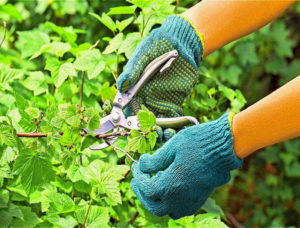
- Zero young replacement shoots are shortened by 1/3 above the buds for better branching.
- The 2-3-year-old branches are renewed: one-year growth is removed, weak lateral shoots with a small number of buds to stimulate the growth of the remaining branches.
- Trim the tops of the young growth on 2-3-year-old branches above the buds for better branching.
- The branches of the second order are shortened with a length of more than 40-50 cm.
- Remove the young growth directed to the center of the bush to prevent thickening.
A black hole in the center on a cut branch indicates a glass lesion. This shoot is completely removed.
Features of pruning black, red and white currants
The red and white varieties have almost the same structure of the bushes and the type of fruiting. In these plants, 7-8-year-old branches are considered old, and the peak of fruiting occurs at 5 years. It is recommended to start formative pruning of bushes at the end of July, after harvest.
Red currant pruning involves:
- removal of all internal young shoots shading the fruiting branches;
- pruning old fruiting branches above the level of the strongest lateral shoot;
- cutting zero shoots coming out directly from the ground around the bush (they can be dug in to get layering);
- removal of damaged, dry and diseased shoots.
A properly formed red currant bush should have up to 25 branches aged 1–8 years.
The principle of pruning black currants is slightly different. This is due to the fact that more berries ripen on two-year-old shoots. Therefore, it is important to completely remove old branches (over 5 years old) and pinch off annual stems. Some gardeners recommend combining formative and sanitary pruning.
Reference.Late black currant varieties bear fruit in August, so the summer procedure is transferred to September - October.
In black currants, it is forbidden to greatly shorten the tops: this leads to the loss of most of the crop. With red and white varieties, this procedure is carried out.
Nuances for bushes of different ages
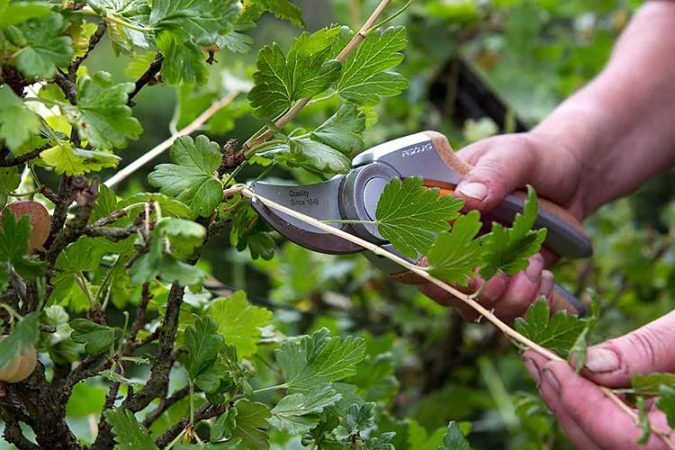
Currants find it difficult to tolerate pruning, for it it is severe stress. If during the procedure, breaks and other damage remain on the shoots, the plant will direct all its forces to heal them. Therefore, it is extremely important to use a sharpened tool in your work.
The principle of cutting currants also depends on its age:
- After planting the seedling, remove all branches above 4 buds from the base of the soil. Next year at least 4-8 shoots from the remaining buds will appear on the bush.
- After 1 year, pinch the tops of all young shoots 1/3 above the buds.
- After 2 years, all zero shoots and parts of skeletal branches are pinched. On biennial branches, one-year growth and strong lateral branches are removed, leaving only strong shoots with a large number of buds to enhance the growth of the remaining branches. To stimulate branching, all the tops of the rest of the growth of the first and second order above the buds are cut off.
- After 3 years, all thickening shoots are cut off.
- For 4 years and beyond, aging shoots are formed. At the end of the season, all old branches are cut at the root, the remaining four-year-old shoots are shortened according to the principle of a three-year-old seedling. Each year, 3–6 zero replacement shoots are left.
Post-procedure care
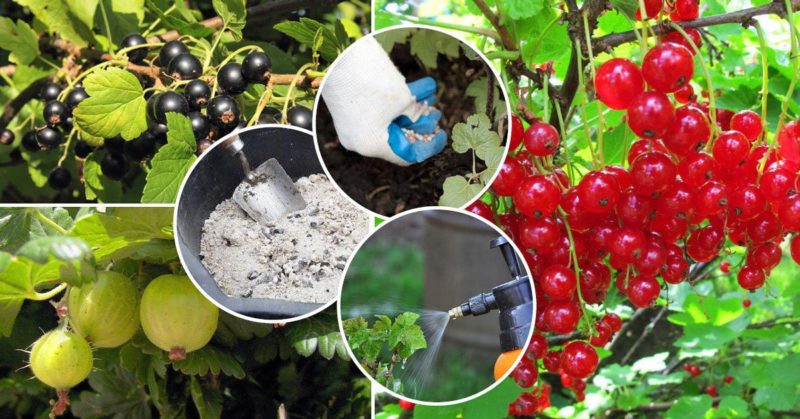
Currants love moisture and respond to sufficient watering with a good harvest... During the period of fruit formation, the culture feels the maximum need for liquid. Excessively dry soil leads to crumbling and shedding of berries. Water is poured under the root in dry weather 1 time in 10 days, spending 50-60 liters for each bush. Spraying on the leaves is not practiced, as it leads to the development of powdery mildew.
After each glaze the soil in the near-trunk circle is loosened to improve aeration of the root system... They do this very carefully: the currant has a superficial root system, the suction roots are barely covered with soil. To reduce the frequency of loosening, the area is covered with mulch with a layer of 6–8 cm (straw, hay, peat). Mulch inhibits the growth of weeds, retains moisture in the soil. As the plant debris decays, nutrients penetrate the soil along with the water.
After the summer pruning, the currants are fed with phosphorus and potassium fertilizers (70-100 g of phosphorus, 30-50 g of potassium or 100-300 g of complex dressings per 1 m²). Compost and humus are applied once every 3 years, 10 kg per 1 bush. Of particular benefit is feeding urea solution (3 matchboxes for 10 liters of water per 1 bush). Plants over 4 years old are fertilized with less urea: 25–30 g per bush. Top dressing is applied in 2 doses with an interval of 14 days.
Experienced gardening tips
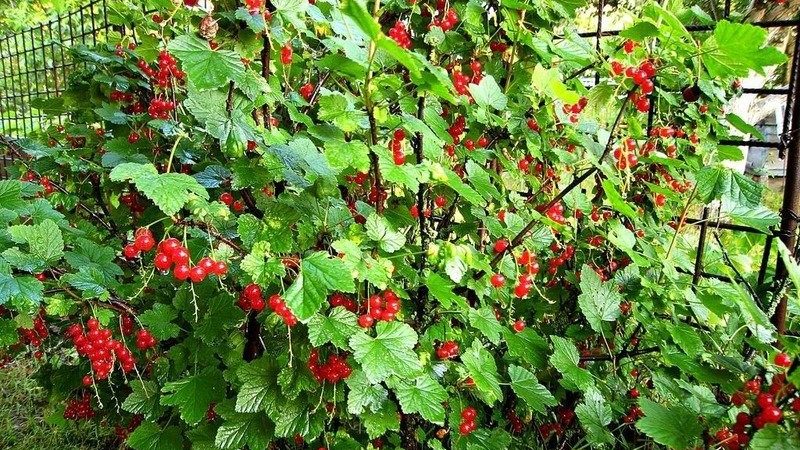
When growing currants, beginners have some difficulties, which will help the advice of experienced gardeners to cope with:
- Removing a large number of shoots is the most common mistake in summer pruning currants. Remember that old, diseased, damaged shoots lying on the ground and one-year thickening growth are subject to removal.
- In July and August, active sap flow begins, so after removing thick branches, treat the sections with garden pitch.
- When pruning red and white currants, do not remove 2-3-year-old shoots: they branch well without additional cutting.
- Leave 9–12 shoots on each bush at 1–3 years of age to maximize yield.
- In the middle of July feed currant bushes organic matter: 1 liter of mullein per 10 liters of water or 0.5 liters of infusion of bird droppings per 10 liters of water. Consumption for 1 bush - 2-3 buckets.
- In order not to carry water to the site for irrigation with buckets, especially if the plantation is large, take a hose, lower it into the bucket and note how long it will take to fill. Multiply this time by the number of buckets you need. For example, if the container is filled in 1 minute, 5 buckets are required for 1 bush - accordingly, keep the hose under the plant for 5 minutes. To make the water more absorbed into the soil, keep the pressure low.
Conclusion
Summer currant pruning is carried out after harvest. The terms of the procedure differ depending on the region of cultivation: in the south, the bushes are cut in June - July, in the northern regions and the middle lane - in August. Red and white currants are cut in September.
A sharply sharpened, disinfected instrument is used in the work and all old, sick, dry and damaged branches are removed, as well as a one-year growth that thickens the central branches. Further care consists in watering, the introduction of organic, potassium-phosphorus dressings and a moderate amount of nitrogen.